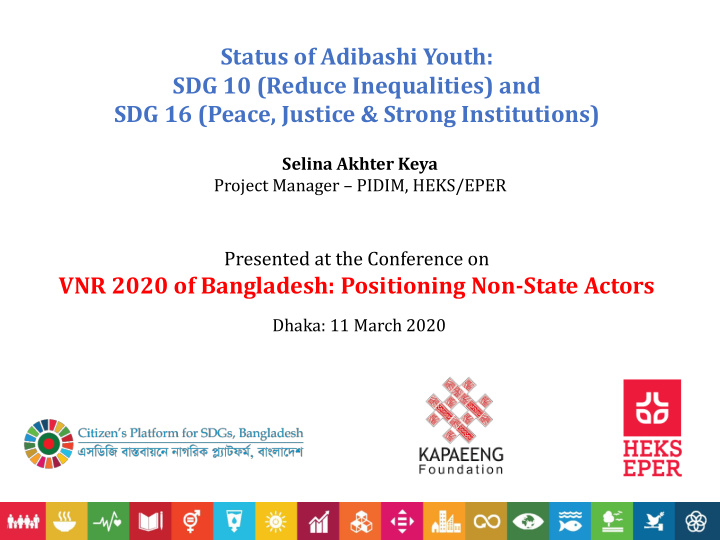



Status of Adibashi Youth: SDG 10 (Reduce Inequalities) and SDG 16 (Peace, Justice & Strong Institutions) Selina Akhter Keya Project Manager – PIDIM, HEKS/EPER Presented at the Conference on VNR 2020 of Bangladesh: Positioning Non-State Actors Dhaka: 11 March 2020
Identified Major Issues • Disproportionate poverty (65% in CHT and above 80% in the plains) affecting social inclusion • Potential loss of demographic dividend due to massive youth unemployment • Inaccessibility to education, specially in tertiary level • Lack of access to employment, inadequate skill, and less/sustainable income opportunities • Adibashi youth women remain less-focused in gender inclusiveness • Relevant policy/Institutional commitment
Progress in SDG 10 & 16 Bangladesh’s Position among South Asian Countries in SDG Index Bangladesh is at 116 th Maldives 47 position while major Bhutan 84 challenges remain in Sri Lanka 93 Nepal 103 attaining Goal 16 and India 115 significant challenges Bangladesh 116 remain attaining Goal 10. Pakistan 130 Afghanistan 153 Source: UNSDSN
Key information on Youth & Adibashi • National Youth Policy define age group 18-35 as Youth. • It is estimated that, 30% of the total population in Bangladesh is youth. • Estimated number of Adibashi youth could be around 536,750.
Education and Skill Development The main challenges in education includes: • Education in their mother language (Books, teachers, training) • High drop-out rate specially in upper level (acute poverty, geographic isolation, learning environment, demotivation for not having decent job, insecurity in case of girl children) • Only 2.63% of the Adibashi youth considered as skilled workers, while over 80% have either no or very limited levels of skills and training • Dropout form the TVET causes due to Socio-economic factors (isolation, mindset, inability to address the special needs by the institutions)
Employment opportunities • Overwhelming dependence on Agriculture (80% in Plains and 72% in CHT) narrows other employment (increasing landlessness and quick industrialization) • Unemployment is higher among tertiary graduates (2.04%) compared to those with no education (0.11%). • Engagement in salaried job/ business is minimal (3% in CHT and less than 1% in the Plains). Only 0.07% Adibashi in north-west has own business. • Investment capacity decreased as savings decreased in last 10 years to 5,745 taka from 6,150 taka among north-west Plainland Adibashis.
Social Protection and Inclusion • Social-safety net schemes are not inclusive towards Adibashi such as, no special allocation for Adibashi student stipend • Limited government initiative to ensure access to finance (only 54% in CHT and 62% in the Plains have access to credit, mostly by the NGOs, Bank with 10% from usury lenders) • Lack of allocation for employment generation, TVET and skill development in social protection provision. • Bribes are to be paid for enrollment to the social safety-net
Non-discrimination and Social participation • Anti-Discrimination Law has POLITICAL not been passed yet. REPRESENTATION OF • Social stigma (lifestyle, food PLAINLAND ADIBASHIS habit, traditional occupations Bengali Adibashi etc.) is very persistent and 13% cause discrimination for Adibashi youths. • Youths are largely left out of political representation and social participation in local, sub-national and national 87% level.
Women’s situation and perceived security • Violence against Women; at least 137 cases of human rights violations were reported in 2018 (both in Plains and the CHT region- a large no. was Youth). • Early Marriage rate is higher both in Plains and CHT. • Maternal and Reproductive Health has implication on mortality rate of Adibashi youth female due to remoteness, inaccessibility to health care facilities and lack of facilities for special needs. • Wage discrimination of Adibashi female is quite high comparing to the male and female from the mainstream. • Plainland Adibashi female youth started wearing veils for their social security, as well not being presented themselves as non-Muslim.
Specific Policy Recommendations • A special survey is required to collect and make disaggregated data by ethnicity, sex, age, disability, employment, poverty, education and health. • Ensure policy intervention through placing separate chapter for Adibashi youth in the 8 th Fifth year Planning, national youth policy 2017, national perspective plan (Vision 2041). • Take special measures to create employment, education and capacity building opportunities • Reserve five percent quota for the Adibashi youth, women and person with disability in govt. jobs and education. • Allocate adequate budget for social safety net and Annual Development Project (ADP).
Specific Policy Recommendations • Ensure education in mother language at least in primary level, provide trained and eligible teachers for Adibashi students to enroll them in quality education for creating future potential. • Develop online based easy-accessible database for land, TVET and essential service allocation. Enhance capacity for Adibashi youth to access digitalized services. • Pass the Anti-discrimination Law immediately. • Implement CHT accord with a specific time frame to ensure the development and security of Adibashi Youth. • Adibashi youth women need to be focused for gender inclusiveness (regarding stopping violence, ensure health facilities, minimize wage discrimination)
Thank You!
Recommend
More recommend